Sally Silvers, Sally Gross, and Sally Bowden share a program.
“Sally.” Seldom has an evening of dance been more appropriately titled. The performances presented by the Construction Company at the University Settlement on Eldridge Street showcased choreography by three vintage Sallys: Sally Gross, who was involved with Judson Dance Theater in the 1960s; Sally Bowden, who emerged in the 1970s, and Sally Silvers, who broke into New York’s downtown scene in the 1980s. (How Sally Hess escaped recruitment is a mystery.)
Pared down and thoughtfully structured, the works by Bowden and Gross suit the intimacy of the Settlement House’s studio theater. These are small dances you need to look at closely to observe how subtly they change and grow. Bowden stays in one spot for a long time in her new Shift. A smallish, handsome, sturdy woman wearing earrings, striped socks, and lively striped trousers below layered knit shirts, she begins by swaying forward and back, facing on a diagonal and occasionally shifting her gaze to look intently past one shoulder. Tinkly piano music starts to play, and percussion feeds in underneath (the music was credited in part to Toubab Krewe and to Marianne Milde).
Gradually Bowden expands her swaying, changes the patterned swing of her arms, gets her hips moving. She’s always grave, always intently focused. She builds up complexity and then prunes it down again. She changes her facing and the timing of her gazes. High childish voices seep into the music. Then a fiddle and percussion. When she first lifts one leg off the floor, it seems like a major change. Niluka Hotaling provides a bit of rosy light when Bowden begins to travel around the space, stopping to corkscrew her legs around each other. But the basic feeling of swinging keeps going, powering all that has happened.
Gross is a different sort of dancer—slim, terse in her movements—elusive despite her firmness. In her new, aptly titled Not Everything Is Seen, she enters from behind the audience, hitting a pair of claves together. The beat isn’t very loud, and it hesitates at times. Everything she does is quiet and deliberate. She decides to go to the studio’s back wall and press the two sticks against it. She puts a black jacket on over her gold one. She sits on a chair and firmly but softly repeats words, only some of which I understand. I hear “cuckoo” and “serviette” and something that sounds like “lezolo” (“laissez-la?”). These and the clear gestures that accompany them encode things she’s not showing and that we are perhaps not to know: a collection of hints—ours to interpret.
A duet and a trio that Gross made in 2011 are equally succinct, but more forthright (that may not be the best word). Both of them ask us to contemplate rearrangements of simple, clear moves, with occasional sly surprises. In Two, Jamie Di Mare and Tanja Meding begin facing us, side by side, stepping forward and back without moving from their spot. Their feet are in synch, but their sharp gestures differ. A beam of light stretches across the floor; Robert Poss’s score suddenly emits a sudden nasal sound. Every move the women make together or separately prints itself on your brain—even the surprise of a dive to the floor or a flurry of arm movements. Briefly, each woman holds one hand before her face in a way that suggests a mirror, but without any hint of vanity. Sometimes we are alike, says the dance, and sometimes we are unalike, but we are more alike than not, and we work well together.
Another Three has more resonance. Three women (Di Mare, Meding, and Heather Lee) sit on a bench. They wear Depression-era dresses, and their hands are folded in their laps. Alex Mincek’s music begins with a soft horn sound, lapping water, a bit of percussion (all played by Mincek on a saxophone—live at the 2011 performances) A pattern develops on the bench—a lean, hard habitat. Lee, who is sitting between the other two, falls forward onto the floor, Meding and Di Mare instantly swivel to face the back wall. When they face front again, they have shifted their places on the bench; when Lee rises and sits, she’s no longer in the middle. Di Mare falls, and again the seating arrangement changes for her return. Meding tries something different (a small rebellion?), walking away and angling her arms around her body, bending and twitching for a while, before returning to the bench. Holding hands, one or the other leans precariously out from their small home base or falls backward, while her companions both restrain her and lean with her. The tensions between unity and separateness, calmly performed, acquire an enigmatic beauty.
Silvers doesn’t appear in her new Confected Size, although she is very much onstage for a managed improvisation titled Live Choreography. The first is a duet for two terrific former members of Merce Cunningham’s company: Dylan Crossman and Melissa Toogood. Confected Size gives off an aura of danger and romance. Video artist Ursula Scherrer creates grainy grayscale images of lines that slant and march and multiply in ways too complex to describe. Bruce Andrews’s sound design collages snippets of music and sounds that can hint at disaster or shadowy cafes. The lighting projects the dancers’ shadows among the moving shapes on the wall.
Toogood’s first gesture is to move her hands up Crossman’s face as they stand face to face. The complicated ways in which their limbs mesh or don’t mesh, their charged meetings and partings often happen at top speed and amid high-energy dancing. He dips below the leg that she has lifted as a barrier or jumps repeatedly against it. She cradles him; he stalks her. As she hurries toward a corner with one arm stretched out, he, trying to keep up, rolls his head along that arm. In one sequence, she keeps unsuccessfully trying to maintain a balance on one leg; he, kiting around the space, arrives just in time to catch her before she hits the floor. They do this over and over. I wasn’t surprised to discover in the program that Confected Size is a “miniature jumpstart” for a piece that Silvers will premiere in November; its source is Alfred Hitchock’s movies.
The duet—which Silvers tells us during Live Choreography owes a lot to the director’s North By Northwest—also figures in this choreographer-at-work item. For it, Silvers invites two dancers, Erin Cornell and Olsi Gleci, to join Toogood and Crossman in the performing area. Building around an intricate portion of the duet, she asks the two newbies to insert themselves into its basic moves—responding to them and affecting their outcome. Eventually, she instructs all of them to collaborate on making the constantly shape-shifting quartet travel across the room.
As you may imagine, the performers have questions, and Silvers’ suggestions may produce both interesting results and dangerous tangles. This is the sort of on-the-spot choreography that spurs those who are knowledgeable about dance to foresee difficulties and imagine solutions, and those unfamiliar with the choreographic process to learn that dancers are very smart people.

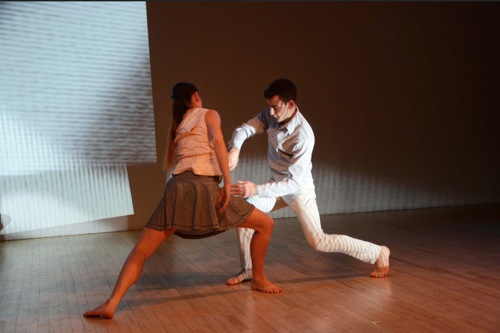
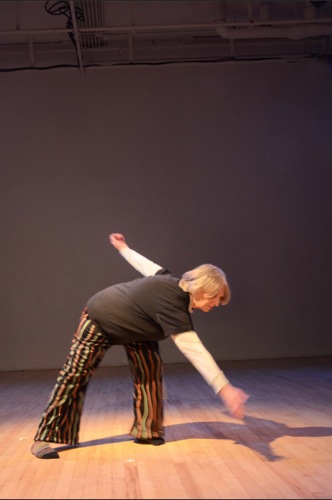
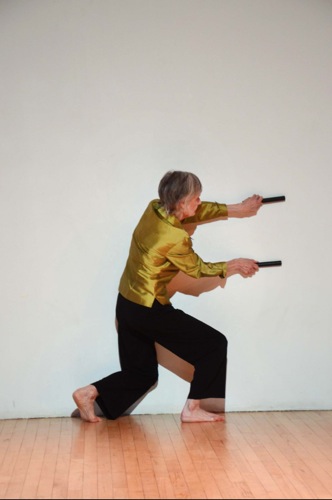
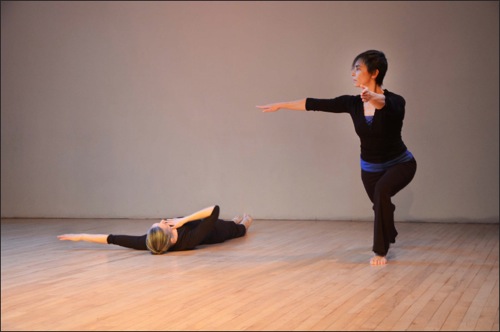
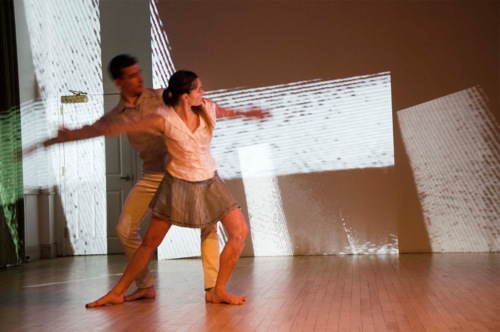
Sally Bowden a charming woman and also a great teacher of Cunningham Technique